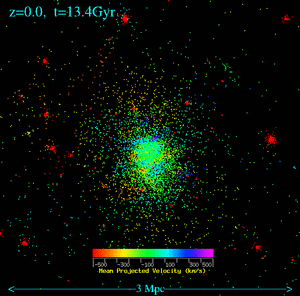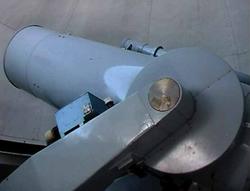|
DARKSTAR Team members
Chris
Flynn , Team Leader
Burkhard Fuchs, Corresponding member
Johan Holmberg, Researcher
Laura Portinari, Researcher
Pasi Nurmi, Researcher
Erik Zackrisson, Researcher
Rami Rekola, Ph.D. student
Janne Holopainen, Ph.D. student
Luca Casagrande, Ph.D. student
Chris Thom, Ph.D. student
Esko Gardner, M.Sc. student
|
Research Developments in 2004
Flynn has led the DARKSTAR project, ``Space Based Studies of Dark
Matter'', which is funded under the
ANTARES program of the Academy of
Finland and TEKES. The Antares program concluded in 2004, and after
detailed review by external referees, was judged a great success.
DARKSTAR continues to be funded by the Academy, through a grant in
association with Flynn's position as a Senior Research Fellow.
Older research reports for 2002 - 2003
Distances to galaxies in the extended local group
Rami Rekola
has
completed his PhD thesis, which focussed on the issue of distances to
nearby galaxies. Rami used three very different techniques with
which to measure distances: the planetary nebula luminosity function,
cepheids, and surface brightness fluctutations. Distances have been
obtained for dwarf elliptical and irregular galaxies of the
extended local group using the NOT,
in collaboration with Helmut Jerjen at Mount Stromlo Observatory.
A Cepheid based distance has been obtained for IC 342, a large,
starburst spiral galaxy,
for which few (and contradictory) distance estimates exist in the
literature, using observations with the NOT over a long baseline (5 years).
Planetary nebulae have been used to make a distance determination to
NGC
253 (using imaging data from the ESO 3.6 meter). This is part
of a longer term program to assemble reliable masses and distances for
the extended local group galaxies with a view to simulating their
dynamics. Many of these galaxies are at distances where the effects of
"dark energy" on the Hubble flow are first noticable; accurate
distances to the galaxies are therefore of particular interest. The
surface brightness fluctuation method has been shown to be a
particularly efficient means of determining good distances, especially
for dwarf galaxies for which other methods cannot be easily applied. We
are planning to use the method to measure distances for large numbers
of nearby dwarfs in an ongoing effort to understand better the local
Hubble flow.

| Part of the
giant spiral galaxy IC 342. It lies just beyond our own Local Group of
Galaxies in another group called Maffei Group or IC342/Maffei Group.
The image above is a combination of images taken with BVRI filters
(roughly blue, visual = green, red, and infrared) by Rami Rekola and
Kari Nilsson at the Nordic Optical Telescope. |
Detailed astrophysics of galaxy clusters
In collaboration with Jesper Sommer-Larsen (Copenhagen, Denmark) and PhD
student Alessio Romeo (Catania, Italy), Portinari has analyzed
the results of an extensive set of cosmological+hydrodynamical simulations of
galaxy clusters. Included processes like metal-dependent cooling, star
formation, stellar feedback, chemical enrichment and thermal conduction affect
the physics of the intra-cluster medium (ICM) improving the predicted density,
temperature and entropy profiles, as well as the L_X-T relation.
A top-heavy Initial Mass Function is necessary to reproduce both the observed
metal content in the ICM and the colour-magnitude relation of cluster
galaxies. The star formation history in simulated clusters is "accelerated"
with respect to the field and decreases steadily from z=2 to 0, as is
observed. The simulated luminosity functions show a deficiency of bright
galaxies in favour of an overgrown central cD galaxy; the problem is related to
the choice of simulating highly relaxed clusters, and to our limited
understanding of the mechanisms that prevent, in the real Universe, the
extensive central cooling flows predicted by theory and simulations.
The simulated clusters also present extended envelopes of intracluster (IC)
stars, contributing 20-40% of the cluster luminosity, as observed. IC stars
are predicted to constitute a kinematically colder system than cluster
galaxies, to form at a slightly higher redshift than the stars within in the
galaxies, to have roughly solar metallicity in the central cluster regions and
a negative metallicity gradient, and to present an alpha-element enhanced
chemical composition, indicating dominant enrichment from Type II supernovae.

|
Simulating Galaxy Clusters: Properties of the Intracluster
Stars. Image by Jesper Sommer-Larsen, Alessio Romeo and Laura
Portinari, TAC, Copenhagen. The intracluster stars are colour coded by
velocity, and show structure in both configuration and velocity
space. Image courtesy Jesper Sommer-Larsen. (More info on this beaut
image here). |
Disk mass to light ratio
The amount of light emitted by groups of stars, relative to their total mass,
is an important quantity in astronomy; it is called the stellar mass-to-light
ratio, or (M/L)*. For many studies, the amount of light emitted may
be the only measurable quantity, and can only be converted into a stellar mass
indirectly by assuming some value for (M/L)*.
The only place where (M/L)* can be measured directly is near the
Sun, in the Milky Way disk. Chris
Flynn of Tuorla Observatory and
Johan Holmberg (then of Lund Observatory) have used data from the
European
Space Agency's Hipparcos
satellite on so-called K giant stars, to measure the total amount of
disk matter, M, near the Sun. Johan has now joined us at Tuorla Observatory
(late 2004), and together with Laura Portinari (who arrived in early
2004), we are now proceeding to a careful measure of the integrated amount of
light, L, emitted by the same disk stellar populations.
One of the ultimate goals is to compare the disk of the Milky Way to those of
other spirals and to the multi-band Tully Fisher relation defined by external
disk galaxies. For this comparison it is fundamental to reconstruct, from the
(essentially volume limited) Hipparcos data-set, the surface luminosity and
column integrated (M/L)* of the Milky Way disk, also distinguishing
between the thick and thin disk contributions. This is accomplished by means
of the detailed vertical mass distribution model developed by Holmberg and
Flynn in their previous study of the local disk mass, a model which has been
constrained via large scale star counts from the Hipparcos and Tycho catalogs.
We have now completed the estimate of the local surface luminosity and
(M/L)* in the V band, based on direct Hipparcos photometry, and we
will next extend the measurement to all other bands covering the full range of
optical and infrared colours (BVRIJHK). This will yield for the first time a
fully multi-band estimate of the local stellar (M/L)* and of the
integrated colours of the stellar populations near the Sun, to be confronted to
the integrated properties of external spirals.
The stellar (M/L)* is also a crucial quantity for the dynamical
analysis of disk galaxies, and for the decomposition of observed rotation
curves into the disk vs. dark halo contribution, which is ultimately a probe of
the structure of dark haloes - a thorny issue in modern cosmology. The radial
variations in stellar (M/L)* over a galactic disk, traced by the
observed colour gradients, are usually disregarded in dynamical analysis yet
they are likely to play a significant role in rotation curve decomposition.
Laura Portinari has analyzed the radial gradients in stellar (M/L)*
predicted by her chemo-photometric models of disk galaxies, and in
collaboration with Paolo Salucci (SISSA,
Trieste) is examining their effect on rotation curve analysis, for an improved
reconstruction of the disk/halo structure of spiral galaxies.
The production of
cosmic Helium
Chris Flynn
of Tuorla Observatory; Raul Jimenez of
the University of Pennsylvania;
James MacDonald of the University of Delaware and Brad Gibson of
Swinburne University of Technology have used data from the European Space
Agency Hipparcos
satellite to measure the amount of Helium which has been produced in
stars relative to the amount of heavier elements, i.e. DY/DZ.
The physical effect being exploited is the broadening of the
lower Main Sequence caused by the spread of metallicity and helium content
in stars.
The team
have found that over the billions of years since the Universe was born,
stars have produced just about exactly twice as much helium
as everything else. The research appeared in the journal
Science in 2003.
We are now intensively following this work up at Tuorla Observatory.
PhD student Luca Casagrande
has been using the remotely controlled 30 cm KVA telescope on the island
of La Palma; he has obtained photometry for a carefully selected set of
K dwarfs, the stars used in the earlier study, with
accurate metallicities. Casagrande's sample of stars is now about three
times bigger than our earlier study; but more importantly, they are
much better selected; they have accurate metallicity data, in some
cases for a range of elements, and we have used a brand new method due
to Wielen and collaborators, termed "mu delta", to remove troublesome
binary stars from the sample.
The multi-band photometry obtained allows us to recontruct the bolometric flux and
the effective temperature of the stars, so that the analysys of the HR diagram
of nearby K dwarfs can be carried out in the theoretical plane, where the
comparison to stellar models is more direct and robust, and moreover the effect
of helium content on the broadening of the lower Main Sequence is more evident.
We are presently analysing this sample in order to produce a significantly
improved estimate of the rate of Helium production in the cosmos. Future plans
include the use of Portinari's chemical models for the Solar
Neighbourhood to simulate the local helium enrichment history and estimate the
amount of helium locked away in remnant stars. Since stars of different masses
produce helium and metals in different proportions and over different
timescales, DY/DZ as reflected in nearby K dwarfs may depend on the specific
star formation and chemical evolution history of the local environment, so that
chemical models are necessary to link the local estimate to the true overall
"cosmic production rate" and to infer YP. This latter quantity is
interesting in light of recent discrepancies between "astronomical" and "CMB"
determinations of YP.
 | The Royal Swedish Academy's 60 cm telescope
at La Palma in the Canary Islands, Spain. The telescope has recently been
upgraded to allow fully remote observing from Tuorla Observatory, in Turku
Finland. We are using a 30 cm piggyback telescope to obtain BVRI colours of a
sample of K dwarf stars in order to determine DY/DZ, the rate of production of
Helium relative to metals in stars. The telescope is also being used as part
of the MAGIC collaboration (More info here).
|
Personnel Movements in 2004
Chris Flynn
spent one month at the Astronomisches Rechen-Institut in Heidelberg,
working with Professor Burkhard Fuchs.
Burkhard has joined DARKSTAR as a corresponding consultant in 2004,
adding considerable theoretical flair to the team.
Eira Kotoneva has accepted a position at the Turku University
Hospital in medical physics, and Jyrki Hänninen has also moved on
to higher things, having accepted a teaching position. Drs. Johan Holmberg and Laura Portinari joined the DARKSTAR
team as post-doctoral researchers in 2004; Portinari later gained
independent funding for her position at Tuorla through the Academy of
Finland. Luca Casagrande and Janne Holopainen continue their PhD
studies, begun in 2003. Janne spent two months at the Swinburne
University of Technology, in Melbourne Australia, and working with
Prof. Brad Gibson. PhD student Chris
Thom visited Tuorla Observatory for two one month visits during
2004, coming to us from the Swinburne in Australia.
Visitors in 2004
- Professor Chanda Jog, Indian Institute of Science,
Bangalore, India, November 2004; disk dark matter
- Chris Thom, Swinburne Institute of Technology,
Melbourne Australia, for a one and two month visit, working on high
velocity stars and high velocity clouds
- Agostino Renda, Swinburne Institute of Technology,
Melbourne Australia, working on simulations of disk galaxy formation
- Dr Jesper Sommer-Larsen, NORDITA/TAC, Copenhagen,
Denmark, working on the Galactic halo and the theory of galaxy formation
- Dr Johan Holmberg, Lund Observatory, Sweden,
several visits working on disk dark matter. Johan later joined DARKSTAR
on a post-doc position
- Professor Gene Byrd, University of Alabama, USA.
Gene was the opponent for Rami Rekola's PhD thesis
|